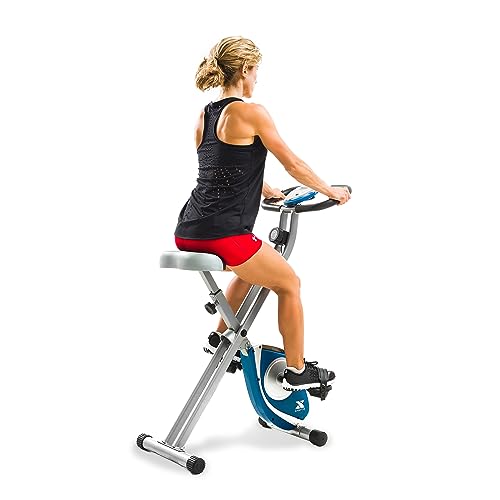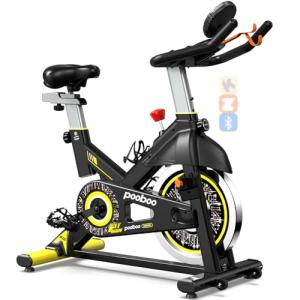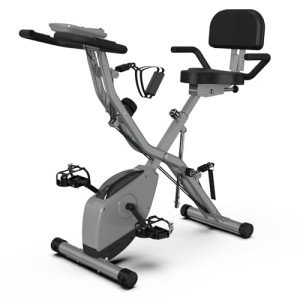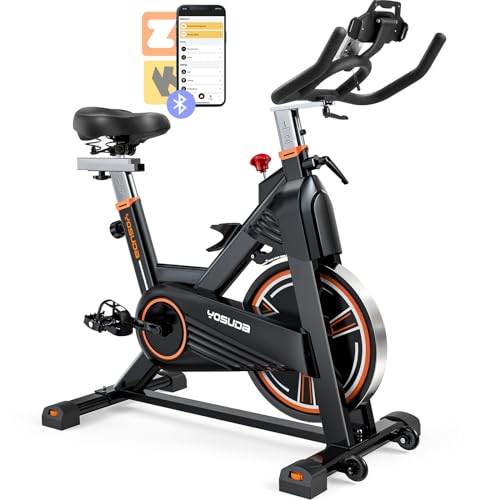Introduction: Pedal Your Way to Fitness
Indoor cycling has taken the fitness world by storm, offering a low-impact, high-energy way to get in shape and stay healthy. Whether you're a seasoned cyclist or new to the saddle, this comprehensive guide will help you understand the benefits, dispel common myths, and gear up for an exhilarating journey toward your fitness goals.
What Is Indoor Cycling and Why It's a Top Choice for Workouts?
Indoor cycling, also known as spinning, is a stationary cycling workout that simulates outdoor cycling in a controlled environment. It's a popular choice among fitness enthusiasts due to its versatility, convenience, and ability to deliver a challenging workout regardless of weather conditions or time constraints.
During an indoor cycling class, you'll ride a stationary bike under the guidance of an instructor who motivates you through varied terrains, speeds, and resistance levels. The result is a full-body workout that engages your muscles, elevates your heart rate, and torches calories.
Debunking Common Myths: Indoor Cycling vs. Outdoor Cycling
While indoor and outdoor cycling share similarities, there are key differences to consider. A common myth is that indoor cycling is easier than outdoor cycling. However, indoor cycling can be just as challenging, if not more so, as you can control the resistance and intensity levels to push your limits.
Another myth is that indoor cycling is boring. In reality, modern indoor cycling classes are dynamic and engaging, often incorporating upbeat music, motivational coaching, and varied routines to keep you entertained and motivated.
Benefits of Indoor Cycling: More Than Just Burning Calories
The benefits of indoor cycling extend far beyond simply burning calories. It's a fantastic cardiovascular exercise that strengthens your heart, improves circulation, and boosts your overall endurance.
Additionally, indoor cycling is a low-impact workout, making it gentle on your joints while still providing an intense workout. It's also an excellent way to build strength in your legs, glutes, and core muscles.
Regular indoor cycling sessions can also improve your mental health by reducing stress, boosting mood, and promoting better sleep.
Who Can Benefit From Indoor Cycling: All Levels Welcome
One of the most appealing aspects of indoor cycling is its inclusivity. Regardless of your fitness level, age, or experience, you can adapt indoor cycling workouts to your needs and capabilities.
Beginners can start with shorter, less intense sessions and gradually increase the duration and intensity as their fitness improves. Advanced cyclists can challenge themselves with longer rides, higher resistance levels, and more complex routines.
Essential Gear For Indoor Cycling: Setting Yourself Up for Success
To get the most out of your indoor cycling workouts, it's important to have the right gear:
Proper Clothing: Choose breathable, moisture-wicking fabrics that allow for a full range of motion. Padded cycling shorts can also enhance comfort during longer rides.
Cycling Shoes: If you plan to attend indoor cycling classes, investing in cycling shoes with cleats that clip into the pedals can provide better power transfer and stability.
Water Bottle: Staying hydrated is crucial during any workout. Keep a water bottle handy and sip regularly throughout your session.
Towel: Bring a towel to wipe away sweat and keep yourself comfortable during the ride.
Heart Rate Monitor: Monitoring your heart rate can help you gauge your exertion levels and ensure you're working out within a safe and effective zone.
Getting Started: Your First Indoor Cycling Session
Embarking on your indoor cycling journey is exciting, but a little preparation goes a long way in ensuring a safe and enjoyable experience. This section guides you through the essentials of choosing the right bike, adjusting it to your body, warming up properly, mastering basic techniques, and cooling down effectively.
Choosing the Right Bike: Upright, Recumbent, or Spin Bike?
The type of indoor cycling bike you choose can significantly impact your workout experience. Let's explore the three main options:
Upright Bike: These bikes mimic the feel of a traditional road bike and are great for engaging your core and upper body. They typically offer a more intense workout due to the upright position.
Recumbent Bike: If you're looking for a more comfortable and low-impact option, recumbent bikes are ideal. They feature a reclined seat and backrest, which can be easier on your back and joints.
Spin Bike: Designed specifically for indoor cycling classes, spin bikes are known for their heavier flywheels, which provide a smooth and realistic riding experience. They're often preferred by experienced cyclists or those seeking a challenging workout.
Ultimately, the best bike for you depends on your personal preferences, fitness goals, and any physical limitations you may have.
Proper Bike Setup: Adjusting Seat, Handlebars, and Pedals
To maximize your comfort and prevent injury, it's crucial to adjust your bike properly before each session. Here are the key adjustments:
Seat Height: When seated on the bike, your knee should be slightly bent at the bottom of the pedal stroke. This ensures proper leg extension and reduces strain on your knees.
Seat Position: The seat should be positioned forward or backward so that, when your foot is at the 3 o'clock position on the pedal, your knee is directly over the ball of your foot.
Handlebar Height: Adjust the handlebars to a height that feels comfortable and allows for a slight bend in your elbows. This helps you maintain good posture and reduces stress on your wrists and shoulders.
Foot Position on Pedals: Place the ball of your foot on the center of the pedal, ensuring your toes are pointing forward. If your bike has toe cages or clips, make sure your feet are securely fastened.
Warm-Up Routine: Preparing Your Body for the Ride
A proper warm-up is essential for preparing your muscles and joints for the demands of an indoor cycling workout. A typical warm-up might include:
5-10 minutes of easy pedaling: Start with a low resistance level and gradually increase your cadence (pedaling speed).
Dynamic stretches: Incorporate movements like leg swings, arm circles, and torso twists to increase blood flow and loosen up your joints.
Basic Cycling Techniques: Pedaling, Posture, and Hand Positions
Good cycling technique can enhance your performance, prevent injury, and make your rides more enjoyable. Here are some fundamental techniques to focus on:
Pedaling: Aim for smooth, circular pedal strokes, pushing down with your heels and pulling up with your toes.
Posture: Keep your back straight, shoulders relaxed, and core engaged. Avoid hunching over or leaning too far forward.
Hand Positions: Vary your hand positions on the handlebars throughout your ride to prevent fatigue and distribute pressure evenly.
Cool-Down Exercises: Gentle Stretches for Recovery
After your workout, a cool-down is crucial for bringing your heart rate back to normal and reducing muscle soreness. Your cool-down might include:
5-10 minutes of easy pedaling: Gradually decrease your cadence and resistance.
Static stretches: Hold stretches for your hamstrings, quads, calves, and lower back for 20-30 seconds each.
III. Beginner-Friendly Indoor Cycling Workouts: Pedaling into Progress
Starting your indoor cycling journey doesn't have to be overwhelming. This section introduces you to a variety of beginner-friendly workouts designed to build your endurance, burn calories, and most importantly, make indoor cycling fun and enjoyable.
Steady-State Rides: Building Endurance and Burning Calories
Steady-state rides are a fantastic starting point for beginners. These workouts involve maintaining a consistent pace and resistance level for a set duration. Steady-state rides help you:
Build Endurance: Gradually increase the duration of your rides to improve your stamina and cardiovascular fitness.
Burn Calories: The longer you ride, the more calories you'll torch.
Develop Basic Cycling Skills: Focus on proper form and technique while enjoying a comfortable pace.
Hill Climb Simulations: Targeting Your Glutes and Hamstrings
Ready to challenge your muscles? Hill climb simulations are your answer. These workouts mimic the experience of riding uphill, engaging your glutes, hamstrings, and quadriceps. Hill climbs are a great way to:
Build Strength: Strengthen your lower body muscles and improve your overall power output.
Increase Calorie Burn: The increased effort required for hill climbs translates to more calories burned.
Add Variety: Incorporate hill climbs into your routine to keep your workouts interesting and prevent plateaus.
Interval Training: Short Bursts for Maximum Impact
Interval training is a highly effective workout method that alternates between high-intensity bursts and recovery periods. This approach has numerous benefits for beginners:
Maximize Calorie Burn: Studies show that interval training can burn more calories in less time compared to steady-state cardio.
Boost Fitness Quickly: The challenging nature of intervals pushes your body to adapt, leading to faster improvements in fitness.
Prevent Boredom: The constantly changing pace and intensity of intervals keep your workouts engaging and prevent monotony.
Incorporating Music and Motivation: Creating a Fun Atmosphere
Music can be a powerful motivator during indoor cycling workouts. Upbeat tunes can help you maintain a high energy level, push through challenging moments, and make your workout more enjoyable. Experiment with different genres and playlists to find what motivates you most.
Tracking Your Progress: Using Apps and Heart Rate Monitors
Tracking your progress can be incredibly motivating and help you stay on track with your fitness goals. Consider using:
Cycling Apps: Many apps offer guided workouts, tracking features, and virtual communities to keep you engaged and accountable.
Heart Rate Monitors: Monitoring your heart rate can help you stay within your target heart rate zone, ensuring you're working out at the right intensity.
Intermediate Indoor Cycling Workouts: Level Up Your Training
Congratulations on mastering the basics! Now it's time to elevate your indoor cycling game with intermediate workouts designed to challenge your muscles, boost your cardiovascular fitness, and take your calorie burn to the next level.
Increasing Resistance: Challenging Your Muscles Further
One of the most effective ways to progress in your indoor cycling journey is to gradually increase the resistance on your bike. Higher resistance levels engage more muscle fibers, leading to:
Increased Strength: As your muscles adapt to the heavier load, they become stronger and more powerful.
Enhanced Endurance: Higher resistance workouts train your muscles to work harder for longer durations, improving your overall stamina.
Greater Calorie Burn: The more effort you exert, the more calories you'll expend during your workout.
High-Intensity Interval Training (HIIT): Amplifying Fat Burn
High-Intensity Interval Training (HIIT) is a popular and effective workout method that involves alternating between short bursts of intense exercise and periods of recovery. HIIT workouts are known for their numerous benefits, including:
Efficient Fat Burning: HIIT has been shown to be more effective at burning fat than traditional steady-state cardio, even after the workout is over.
Improved Cardiovascular Health: HIIT challenges your heart and lungs, leading to improvements in overall cardiovascular fitness.
Time-Efficient: HIIT workouts can be completed in a shorter amount of time than traditional cardio, making them ideal for busy schedules.
Incorporating Sprints: Boosting Cardiovascular Fitness
Sprints are short bursts of all-out effort that challenge your cardiovascular system and help you reach your maximum heart rate. Adding sprints to your indoor cycling workouts can:
Boost Your VO2 Max: VO2 max is a measure of your body's ability to utilize oxygen during exercise. Sprints can significantly improve your VO2 max, leading to better cardiovascular fitness.
Enhance Fat Burning: Sprints increase your metabolic rate, both during and after the workout, resulting in increased calorie and fat burn.
Break Through Plateaus: Sprints can help you break through fitness plateaus by pushing your body beyond its comfort zone.
Adding Variety: Different Workouts for Different Goals
Variety is key to keeping your indoor cycling workouts engaging and preventing boredom. Here are some ways to add variety to your routine:
Mix Up Your Terrain: Simulate different terrains like hills, flats, and valleys to challenge your muscles in different ways.
Vary Your Cadence: Experiment with different pedaling speeds (cadence) to work different muscle groups and energy systems.
Try Different Workout Formats: Explore different workout formats like HIIT, endurance rides, or virtual cycling classes to keep things fresh.
Listening to Your Body: Adjusting Workouts as Needed
As you progress in your indoor cycling journey, it's important to listen to your body and adjust your workouts accordingly.
Rest and Recovery: Don't be afraid to take rest days to allow your muscles to recover and prevent overtraining.
Modify Intensity: If you're feeling fatigued or experiencing pain, reduce the intensity or duration of your workout.
Consult a Professional: If you have any concerns about your health or fitness, consult with a doctor or certified trainer.
By paying attention to your body's signals and making necessary adjustments, you can ensure a safe and effective indoor cycling experience.
Advanced Indoor Cycling Workouts: Pushing Your Limits
Ready to take your indoor cycling prowess to the next level? If you're an experienced cyclist craving a challenge, these advanced workouts are designed to push your limits, maximize your results, and transform you into a cycling powerhouse.
Tabata Intervals: A Brutal But Effective Workout
Tabata intervals are a high-intensity workout protocol consisting of 20 seconds of all-out effort followed by 10 seconds of rest, repeated for eight rounds. This intense format is known to deliver impressive results in a short amount of time. Tabata intervals can:
Boost Metabolism: The high-intensity nature of Tabata intervals elevates your metabolic rate both during and after the workout, leading to increased calorie burn.
Improve Anaerobic Fitness: Tabata intervals challenge your anaerobic energy systems, enhancing your body's ability to perform short bursts of intense exercise.
Maximize Time Efficiency: A Tabata workout typically lasts only four minutes, making it a great option for those with busy schedules.
Endurance Challenges: Can You Ride for an Hour?
If you're looking to build serious endurance, challenge yourself with longer rides. Aim to gradually increase your ride duration, working your way up to a full hour or even longer. Endurance challenges offer several benefits:
Improved Cardiovascular Health: Long rides strengthen your heart and lungs, improving your overall cardiovascular fitness.
Increased Mental Toughness: Completing long rides requires mental fortitude and the ability to push through fatigue, building mental resilience.
Enhanced Fat Burning: Longer rides tap into your fat stores for energy, promoting long-term fat loss.
Incorporating Weights: Combining Cardio and Strength
Take your indoor cycling workouts to the next level by incorporating weights. Light dumbbells can be used during your rides to add an upper body strength component. Incorporating weights can:
Increase Calorie Burn: Engaging more muscle groups during your workout leads to a higher calorie expenditure.
Build Full-Body Strength: Combining cardio with strength training helps you achieve a more balanced and well-rounded fitness level.
Add Variety: Incorporating weights adds a new dimension to your indoor cycling routine, keeping it fresh and challenging.
Joining Virtual Classes: Riding with a Community
Virtual cycling classes offer a fun and social way to get your workout in. Many online platforms offer live and on-demand classes led by experienced instructors. Virtual classes can:
Provide Motivation and Accountability: Riding with others can push you to work harder and stay motivated.
Offer Professional Guidance: Experienced instructors can provide valuable guidance on form, technique, and workout strategies.
Build Community: Connecting with other cyclists online can foster a sense of community and camaraderie.
Setting Personal Goals: What Do You Want to Achieve?
As an advanced cyclist, setting personal goals is crucial for staying motivated and continuing to progress. Your goals might include:
Increasing Your Average Speed: Track your progress and strive to increase your average speed over time.
Riding Longer Distances: Challenge yourself to ride longer distances or complete a century ride (100 miles).
Improving Your Power Output: Invest in a power meter to track your power output and work towards increasing your wattage.
By setting clear and measurable goals, you can create a roadmap for your indoor cycling journey and celebrate your achievements along the way.
Targeting Specific Muscle Groups: Sculpting Your Body
Indoor cycling is a fantastic full-body workout, but you can strategically target specific muscle groups to achieve your desired physique. This section will guide you through exercises and techniques to sculpt your legs, core, arms, and more, all while enjoying the benefits of your indoor cycling routine.
Leg Workouts: Quads, Hamstrings, and Calves
Your legs are the powerhouse of indoor cycling, and targeted exercises can enhance their strength and definition:
Quads (Front of Thighs): Focus on high-resistance hill climbs and seated sprints to engage your quadriceps muscles. Stand up out of the saddle for short intervals to further activate these muscles.
Hamstrings (Back of Thighs): Increase resistance and lean forward slightly to emphasize your hamstrings during seated climbs.
Calves: Stand up on the pedals and lift your heels during climbs to work your calf muscles. You can also try single-leg pedaling drills to isolate each calf.
Core Engagement: Strengthening Your Abs and Back
A strong core is essential for maintaining proper posture and preventing injury during indoor cycling. Engage your core muscles throughout your ride by:
Maintaining Good Posture: Keep your back straight, shoulders relaxed, and core engaged throughout your workout.
Adding Standing Intervals: Standing out of the saddle naturally engages your core muscles to stabilize your body.
Incorporating Core Exercises: Supplement your indoor cycling with exercises like planks, crunches, and Russian twists to further strengthen your core.
Arm Workouts: Engaging Your Upper Body
While primarily a lower body workout, indoor cycling can still engage your arms and upper body. Here's how:
Push-Ups on Handlebars: During a recovery period, carefully position yourself for push-ups using the handlebars for support. This engages your chest, triceps, and shoulders.
Resistance Band Exercises: Attach a resistance band to your bike or a stable anchor point and perform exercises like bicep curls or tricep extensions.
Off-Bike Strength Training: Supplement your indoor cycling with upper body strength training exercises like rows, presses, and curls.
Combining Indoor Cycling with Other Exercises: Full-Body Fitness
For a well-rounded fitness routine, consider combining indoor cycling with other forms of exercise. This can help you target additional muscle groups, prevent overuse injuries, and keep your workouts fresh and exciting. Some great options include:
Strength Training: Incorporate strength training exercises for your upper body, lower body, and core on days when you're not cycling.
Yoga or Pilates: These practices can improve flexibility, mobility, and core strength, all of which are beneficial for cyclists.
Swimming or Running: Cross-training with other cardio activities can enhance your overall fitness and cardiovascular health.
Creating a Personalized Workout Plan: Tailored to Your Needs
The most effective way to target specific muscle groups is to create a personalized workout plan that aligns with your individual goals and fitness level. Consult with a certified trainer to develop a plan that includes:
Specific Exercises: Select exercises that target the muscle groups you want to focus on.
Progressive Overload: Gradually increase the intensity, duration, or frequency of your workouts to continue challenging your muscles.
Rest and Recovery: Allow your muscles adequate time to rest and recover between workouts.
By tailoring your workout plan to your specific needs, you can maximize your results and achieve the sculpted physique you desire.
Nutrition and Hydration: Fueling Your Indoor Cycling Success
To get the most out of your indoor cycling workouts, it's crucial to fuel your body properly. Proper nutrition and hydration will not only enhance your performance but also aid in recovery and overall well-being. This section explores what to eat and drink before, during, and after your indoor cycling sessions.
Pre-Workout Nutrition: What to Eat Before You Ride
What you eat before your indoor cycling session can significantly impact your energy levels and stamina. Aim for a balanced pre-workout meal or snack that includes:
Complex Carbohydrates: These provide sustained energy throughout your workout. Opt for whole grains, fruits, and vegetables.
Lean Protein: Protein helps repair and build muscle tissue. Choose sources like chicken, fish, tofu, or Greek yogurt.
Healthy Fats: Fats provide sustained energy and help you feel full. Include avocado, nuts, or seeds in your pre-workout meal.
Avoid overly greasy or heavy foods, as these can lead to indigestion and discomfort during your ride.
Intra-Workout Hydration: Staying Hydrated During Your Session
Staying hydrated during your indoor cycling workout is essential for optimal performance and preventing dehydration. Sip water regularly throughout your ride, aiming for:
6-8 ounces of water every 15-20 minutes: This will help replace fluids lost through sweat.
Electrolyte Drinks: If you're sweating heavily or riding for longer durations, consider using electrolyte drinks to replenish lost minerals like sodium and potassium.
Avoid sugary drinks or sodas, as these can lead to energy crashes and dehydration.
Post-Workout Recovery: Replenishing Your Body
After your workout, it's important to refuel your body and promote recovery. A balanced post-workout meal or snack should include:
Protein: To repair and rebuild muscle tissue.
Carbohydrates: To replenish glycogen stores (your body's primary fuel source).
Electrolytes: To replace lost minerals through sweat.
A good rule of thumb is to consume a post-workout snack or meal within 30 minutes of finishing your ride.
Creating a Balanced Diet: Supporting Your Fitness Goals
While pre-, intra-, and post-workout nutrition are essential, it's also important to maintain a balanced diet overall to support your fitness goals and overall health. Aim for a diet that includes:
Plenty of Fruits and Vegetables: These provide essential vitamins, minerals, and fiber.
Whole Grains: Choose whole-wheat bread, brown rice, and quinoa over refined grains.
Lean Protein: Incorporate fish, poultry, beans, and tofu into your diet.
Healthy Fats: Include avocado, nuts, seeds, and olive oil.
Limit processed foods, sugary drinks, and unhealthy fats to optimize your health and fitness.
Supplements for Cyclists: When and If to Consider Them
While a healthy diet should provide most of the nutrients you need, some cyclists may benefit from supplements. Consult with a registered dietitian or doctor to determine if supplements are right for you. Some supplements that cyclists may consider include:
Electrolytes: To replenish lost minerals during long or intense rides.
Protein Powder: To aid in muscle recovery and growth.
Creatine: To enhance muscle strength and power.
It's important to note that supplements should not be used as a substitute for a healthy diet. Always consult with a healthcare professional before starting any new supplement regimen.
Staying Motivated: Making Indoor Cycling a Habit
Staying motivated is key to achieving your fitness goals with indoor cycling. Whether you're a seasoned cyclist or new to the saddle, maintaining enthusiasm and consistency can be challenging at times. This section explores strategies for staying motivated, making indoor cycling a habit, and enjoying the journey toward a healthier, fitter you.
Setting Realistic Goals: Don't Overdo It At First
Setting achievable goals is crucial for staying motivated. Start with small, manageable goals, and gradually increase them as your fitness improves. This approach will help you build confidence and avoid burnout. For example, you could start with a goal of cycling for 20 minutes three times a week and gradually increase the duration or frequency over time.
Finding a Workout Buddy: Making It Social
Working out with a friend or family member can make indoor cycling more enjoyable and help you stay accountable. You can encourage each other, compete in friendly challenges, and celebrate your achievements together. Consider joining a virtual cycling community or online forum to connect with like-minded individuals and find a workout buddy.
Tracking Your Progress: Seeing Results Is Motivating
Tracking your progress is a powerful motivator. Seeing how far you've come can inspire you to keep going and push your limits. Consider using a fitness tracker, app, or journal to record your workouts, track your metrics (distance, speed, calories burned), and monitor your progress over time.
Exploring Different Music and Videos: Keeping It Fresh
Variety is key to preventing boredom and maintaining motivation. Experiment with different music genres and tempos to find what gets you energized and keeps you pedaling. Many indoor cycling apps and platforms offer a wide range of scenic rides and virtual classes, allowing you to explore new destinations and challenge yourself with diverse terrains.
Rewarding Yourself: Celebrating Your Achievements
Don't forget to celebrate your successes along the way! Rewarding yourself for achieving your goals can reinforce positive behavior and keep you motivated. Your rewards don't have to be extravagant – they could be as simple as treating yourself to a new workout outfit, a massage, or a healthy meal out.
By implementing these strategies, you can make indoor cycling an enjoyable and sustainable habit, leading to a healthier, happier you.
Summary
This comprehensive guide to indoor cycling workouts covers everything you need to know to get started and excel in this popular fitness activity.
It starts with an introduction to indoor cycling, debunking common myths and highlighting its diverse benefits, from calorie burning and muscle building to improved cardiovascular health and mental well-being.
The guide then walks you through your first indoor cycling session, covering essential gear, bike setup, warm-up routines, basic cycling techniques, and cool-down exercises.
Beginner, intermediate, and advanced workouts are provided, with options for steady-state rides, hill climbs, interval training, HIIT, endurance challenges, and even incorporating weights.
The guide also emphasizes the importance of nutrition and hydration, offering tips for pre-workout meals, intra-workout hydration, and post-workout recovery to maximize your results. It also provides strategies for staying motivated, setting goals, and making indoor cycling a sustainable habit.
Finally, the guide covers safety considerations, common mistakes to avoid, and when to seek professional advice, ensuring a safe and enjoyable experience.
Whether you're a beginner or a seasoned cyclist, this guide provides valuable insights and practical tips to help you achieve your fitness goals and sculpt your body through indoor cycling.







